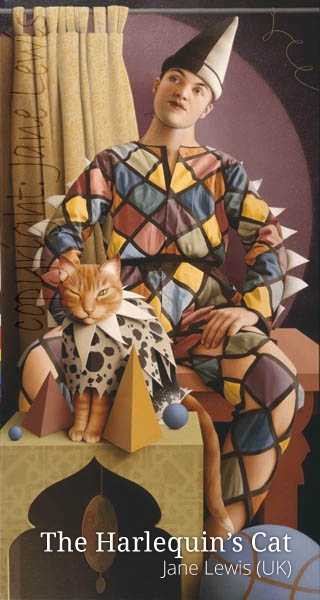The Joker

Harlequin, the French name of the Commedia dell’ arte character Arlecchino, the Joker figure of the cards that inspired the archenemy of Batman, originates back to the devilish character found in medieval passion plays. Jane Lewis depicts him in The Harlequin’s cat as the light-hearted young manfirst introduced in the Italian theatre, but with the chequered costume that he acquired from 17th century Parisian fashion.
More sophisticated than the typical clown Harlequin was constantly looking for ways to thwart the plans of his master Pantalone, a history that is echoed inPlaying with time (2009) by Jacek Lipowczan, where the characters are playing cards in a work that masterfully combines all the landmarks in the history of Harlequin; on the lower right the stakes, the gondola and the miniature St. Mark’s Campanile link him to the Venice carnival, while the the flag of England on the shoulder of Pantalone marks the home of the famous Harlequinade.

As a result of the popularity of Commedia dell’ arte in Europe in the 17th century the English developed a comic theatrical genre that focused on the love interest of Harlequin for Columbine, the daughter of Pantalone, who wants to keep the lovers apart. Cristina Crestani was inspired by this story and in Arlecchino e la sua bella (Harlequin and his beautiful) she portrays the lovers kissing while riding on a white horse like a knight and maid from a medieval story. The duality of Harlequin as a wicked character and romantic hero is depicted in the skillfully drawn Untitled portrait (2013) by Nejc Smodis, while Oana Bolog-Bleich by putting a Harlequin-like figure in the centre of her work titled The Magic Flute (2013) highlights the ability of the character to have everyone dancing to his tune by concocting all sorts of tricks. Joker, the insane rival of Batman, whose figure was inspired by the respective playing card, possessed these skills to a diabolically sinister extent, but his connection to Harlequin can be traced to his sidekick Harley Quinn with the typical chequered costume in red-and-black complementing the references of her name.
The Harley Quinn (2013) of Tavo Montañez is a very characteristic portrait of the girl who became obsessively infatuated with the Joker and always returned to him despite being abused as a means to get to Batman.
Annita Apostolaki is an art professional with an MA from the Sotheby’s Institute of Art and a BA in Archaeology & History of Art. Annita is now Curatorial Assistant at the Athens Biennale and a contributing author for USEUM.
